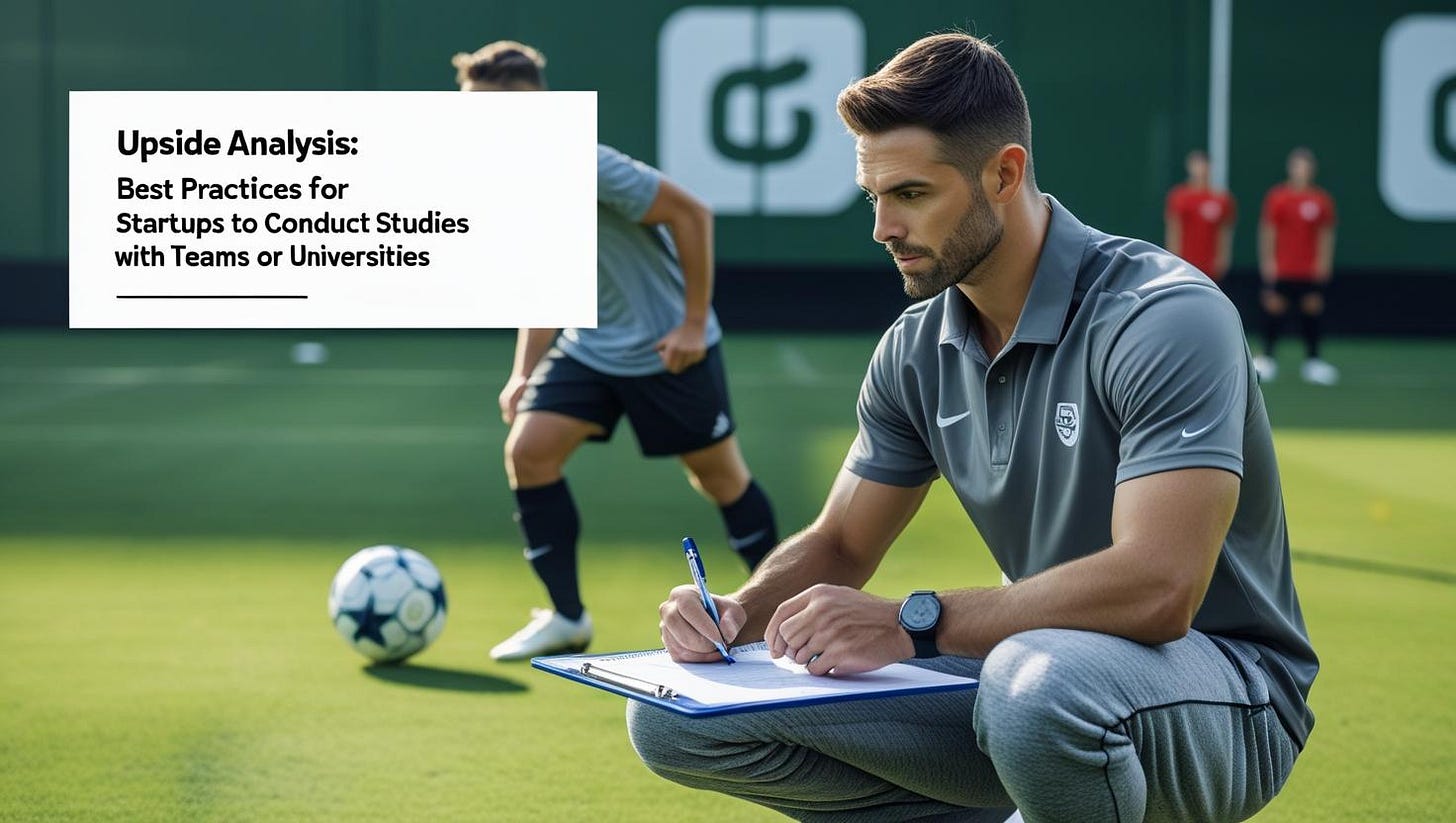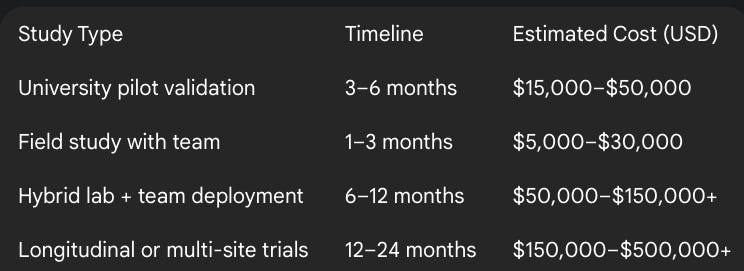📚 Upside Analysis: Best Practices for Startups to conduct studies with Teams or Universities
Startups in sports tech frequently promise revolutionary impact—enhancing performance, preventing injuries, or accelerating recovery. Yet, without independent validation, these claims often meet skepticism from elite teams, practitioners, and investors. Collaborating with universities and sports organizations to conduct structured studies helps ensure credibility, supports commercialization, and fosters product refinement.
The Challenge: Unsubstantiated Claims in Performance Tech
Many startups rely on internal tests or anecdotal feedback to support product claims like “reduces injury risk by 30%” or “improves reaction time by 20%.” Without third-party, statistically significant studies, these assertions are difficult to trust. Elite teams vet dozens of technologies and prioritize solutions backed by peer-reviewed research or data from comparable high‑performance environments.
Why Validation Through Studies Is Critical
Builds credibility & trust among coaches, sports scientists, and medical staff.
Accelerates adoption: elite teams favor products with documented efficacy.
Drives investor and strategic interest, especially when outcomes are published or proven in team settings.
Supports product iteration by revealing strengths, limitations, and areas for optimization.
Enables regulatory or institutional acceptance, aligning with compliance or reimbursement requirements.
Methods for Startups to Conduct Studies With Universities and Teams
A. Academic-Led Controlled Trials
Partner with university labs specializing in biomechanics, physiology, or sports medicine. Fund IRB-approved controlled studies comparing your tech against gold-standard measures.
Example: The University of Michigan partnered with Samsung’s Galaxy Watch to validate VO₂ max and sweat loss estimates using treadmill and outdoor runs across distances from 2.5 km to 20 km, benchmarking smartwatch data against lab-grade sensors .
B. Field Studies With Teams
Deploy your product in real training or recovery settings with elite or collegiate teams. Track usage over weeks or months and compare outcomes against historical or matched control athletes.
C. Hybrid Academic + Field Models
Combine lab-based validation with real-world testing for robust evidence of both reliability and applicability.
Example: Mode‑tronic gait or wearable neuromodulation tools are validated in University labs first then trialed with elite athletes for practical assessment (common industry practice).
Retrospective Data Analysis
If your tech already has usage in real environments, work with academia to analyze historical data and outcomes—e.g. injury frequency, performance metrics, biometric changes.
Retrospective innovation via Knowledge Transfer Partnerships (KTPs)
Programs like Innovate UK’s KTP facilitate joint research between startups and universities.
Example: TG0 (smart insole startup) partnered with University of Portsmouth under a KTP to validate pressure‑sensing AI insoles for biomechanical analysis, advancing publication in Intelligent Sports & Health (Source: The Outpost)
Typical Timeline and Cost to Do Studies
Estimating based on scope:
These estimates depend on variables including number of participants, lab equipment use, IRB/institutional costs, researchers' time, data analysis, and publication expenses.
🔬 Different Levels of Studies Conducted by Universities with Startups
When startups partner with universities to validate their products, the type and depth of the study vary based on research goals, budget, and stage of product development. Here are the main types:
Pilot Studies
These are small, exploratory studies typically conducted in the early phases of development.
Aim to test feasibility, refine methodology, and gather initial performance data.
Often used to gain early feedback from academic or team partners and to shape future large-scale research.
Example: A wearable tech startup may partner with a university kinesiology lab to measure basic usability and initial biometric outputs on a small group of athletes.
Observational Studies
Conducted in real-world settings without direct manipulation of variables.
Track how a product is used and what outcomes (e.g., performance, injury rates, perceived recovery) emerge over time.
Useful for identifying correlations and building a case for further controlled trials.
Example: A hydration-tracking company might work with a university to monitor fluid levels and player compliance during training camps.
Randomized Controlled Trials (RCTs)
Considered the gold standard in research due to their rigor and ability to establish causation.
Participants are randomly assigned to an intervention group (e.g., using the startup’s tech) or a control group.
Allow startups to make strong, evidence-backed claims, but these studies are resource-intensive and require ethical clearance, academic oversight, and robust data analysis.
Example: A startup offering neurostimulation for recovery might run an RCT with a D1 athletics program comparing their product’s outcomes to traditional recovery methods.
Longitudinal Studies
Monitor the same participants over extended time periods, sometimes over an entire sports season or year.
Help identify long-term trends, effects on athlete health and performance, or reductions in injuries.
Require strong team-university coordination and robust data management systems.
Example: A team analytics platform might study how its usage over an entire season correlates with athlete readiness, injury risk, or performance output.
✅ What’s Important When Publishing Studies in Respected Publications
Publishing in respected, peer-reviewed journals not only validates a startup’s product but also builds trust within elite sports. Here are the key elements that matter:
Scientific Integrity
Research must be methodologically sound—following ethical protocols, proper control designs, and valid statistical methods.
Findings must reflect the data, even if outcomes are neutral or unfavorable.
Objectivity and Independence
Studies must be driven primarily by researchers or institutions, not by the startup itself.
Clear boundaries must be maintained to avoid bias—especially in data collection, interpretation, and publication.
Objective design increases credibility with coaches, scientists, and investors.
Transparency and Disclosure
Any conflicts of interest, such as funding or employment ties between the startup and researchers, must be openly disclosed.
The study's methodology and data sources should be transparent and, if possible, made available for review or replication.
Trust and Credibility
Teams and practitioners must be able to trust the findings. That trust comes from transparent processes, academic oversight, and clear communication.
Ethical approval and informed consent processes ensure athlete and participant protection.
Replicability and Peer Review
Research should be replicable by others in similar settings—this is key to gaining credibility in elite sports and among scientific communities.
Peer-reviewed journals provide external validation, ensuring that research is reviewed and approved by subject matter experts before publication.
Collaborative Transparency
Successful studies are built on strong partnerships between startups, universities, and teams, where each party’s role and interests are clearly aligned.
It’s important that the research is not seen as a marketing vehicle, but as a meaningful contribution to evidence-based practice in sports science.
Examples of Startup–University–Team Studies & Outcomes
✅ Samsung × University of Michigan (Wearable Study)
Objective: Validate Galaxy Watch measurements vs. lab standards for VO₂ max and sweat loss in runners.
Outcome: Eight-month controlled study with treadmill and outdoor trials across a range of distances, leading to credible benchmarking of smartwatch sensors (Source here).
Impact: Strengthened both academic and commercial positioning.
✅ TG0 Smart Insoles + University of Portsmouth KTP
Objective: AI-powered pressure-sensing insoles for biomechanics and performance monitoring.
Outcome: Published results in Intelligent Sports & Health, validating technology and methodology.
Impact: Enhanced product credibility and academic publication credentials (Source here).
✅ Sanford Research × High School Football (IMU Pilot)
Objective: Use instrumented insoles (IMUs) to monitor player workload, acceleration, contact forces, and field surface interactions.
Outcome: Piloted 35 athletes in situ; collected accelerometer and pressure data; set foundation for future multi-site injury-risk research (Source here).
Impact: Demonstrated feasibility and generated interest for expansion.
Recommendations to Startups
Define hypotheses clearly: target measurable outcomes directly tied to your value proposition.
Select credible academic and team partners: university labs known for biomechanics, physiology, or rehab research add weight.
Decide on study type early: pilot lab vs. field trial vs. hybrid — each serves different strategic goals.
Formal agreements upfront: address IP ownership, publication rights, confidentiality, and data usage.
Balance rigor with usability: controlled lab results matter, but field validation ensures real-world uptake.
Plan for dissemination: publish peer-reviewed papers, white papers, and case studies for marketing and investor engagement.
Budget appropriately: ensure you’re prepared for associated costs and timelines before committing.
Pilot early and iterate: start small, learn quickly, then scale validation as credibility grows.
Conclusion
Conducting structured studies in collaboration with universities and sports teams is a powerful way for sports-tech startups to build trust, refine their product, and accelerate market adoption. Real-world and controlled validations lend credibility with practitioners and investors. While such research takes time and resources, the strategic return—enhanced legitimacy, improved product performance, and increased marketability—is substantial. Startups that prioritize evidence-based validation are far more likely to achieve lasting impact in the high-performance sports ecosystem.
You may also like:


